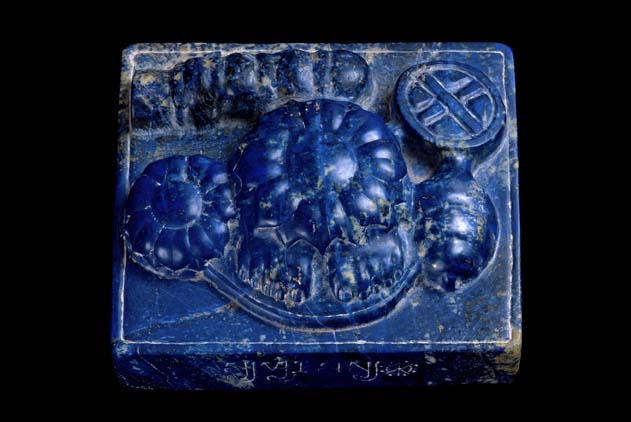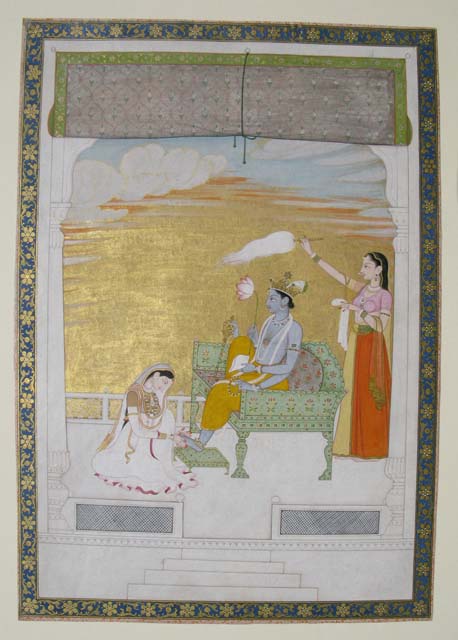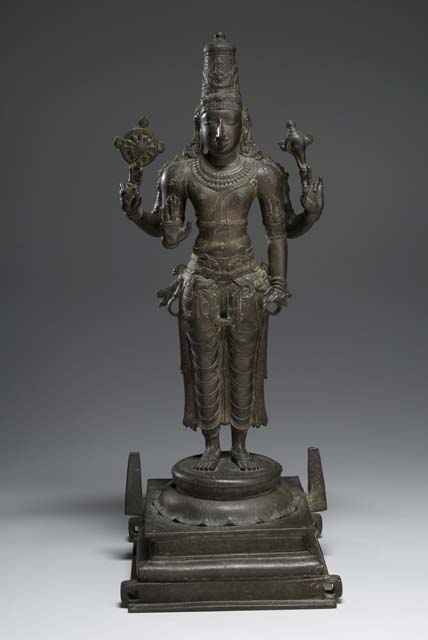
Vishnupada, India or Bangladesh, circa 500
Lapis lazuli
2 x 4 3/8 x 3 3/4 in. (5.1 x 11.1 x 9.5 cm)
Collection of Anthony d’Offay, London
Photo: Courtesy of John Eskenazi Ltd.
Vishnu, Hinduism’s Blue Skinned Savior
Q and A with Joan Cummins, Curator of South Asian Art, Brooklyn Museum
1. Why did you decide to highlight Vishnu in the exhibition instead of some of the other gods such as Shiva or Ganesha?
Simply put, Vishnu was long overdue for an exhibition. The Philadelphia Museum of Art did a marvelous exhibition on Shiva in the 1980s. That show was in many ways my model. The Smithsonian did a lovely show on Devi about ten years ago. Last I heard, there were two Ganesh shows in the works.
There have been many shows on Krishna, but no major loan show that tackled the question of how Krishna fits into the larger tradition of Vaishnavism. I felt like Vishnu was a wonderful subject for a big show because he has so many manifestations and has been worshipped for such a long time by people in so many different regions. The visitor would never get bored because every time you turn a corner there’s a new avatar and new stories to go with it, as well as new art forms celebrating the avatar.
2. How long did it take to organize this exhibit and get permissions from the lending institutions? Also the thoughtful essays in the catalogue! What kind of a time range are we looking at here?
I worked on this show for five years. I was in touch with most of the lending institutions early on, and I started reading the scriptures and scholarship right from the start because I knew that I would need time to synthesize it all. I gave myself far too little time to write the catalogue, but the ideas had been brewing in my head for four years, so it turned out to be relatively easy to put it all down on paper.
3. What was the most difficult part of organizing this – any really mind-boggling task or anecdote?
Often it’s the less glamorous aspects of organizing an exhibition that are really mind-boggling. The registrars who arranged for the movement of art objects into and out of both museums (the Frist Center in Nashville and the Brooklyn Museum) had a lot of juggling and attending to details, with 175 objects traveling from 40 different sources, some of them overseas.
Most museums require that a courier be present when their objects are being unpacked and installed. If a display case has objects from three different museums in it, then the couriers from all three institutions need to be present when the case is installed and closed. So scheduling is a drag. Some of the objects arrived without proper mounts or frames so those needed to be created on the fly. Other objects had special handling requirements, like big stone sculptures that needed rigging and textiles that needed to be unrolled. Our registrars were superheroes.
4. Have you been to India? Any thoughts or anecdote to share?
I have been to India many times, but between work and my family life it hasn’t been possible to go back in over 10 years. I’m itching to go again. I was last there for the millennium new year. I spent it on the roof of a small palace in Udaipur, overlooking the lake. They were setting off fireworks right next to us — like 10 feet away. It was deafening and completely terrifying but in that exhilarating way that makes you giggle despite yourself. A friend of a friend cooked a proper Rajasthani dinner that night and it was one of the best meals I’ve ever eaten.
A lot of my fondest memories of India involve that mix of discomfort and exquisite beauty: insane, five-hour-each-way jeep rides to see perfectly preserved tenth-century temples in the middle of nowhere, and catching glimpses of nilgai and dancing peacocks along the way.

Lakshmi Massaging the Foot of Vishnu, India, circa 1765–70
Opaque watercolor, gold, and silver on paper
10 3/4 x 7 3/8 in. (27.3 x 18.7 cm)
Collection of Catherine and Ralph Benkaim
5. The objects range from ancient sculpture to miniature paintings to Bollywood posters. What does this tell you about the continuing place of religion in India and amongst the Diaspora?
By ending with the Bollywood posters, I wanted to make the point that Hinduism isn’t simply an ancient religion. It’s a living religion, and one that adapts to the changing times. People are still telling the same stories, but they’re using new technologies to bring them to life. Modernity has had a secularizing effect on most corners of the world, but the stories of the avatars continue to resonate with many non-practicing Hindus because the stories are part of their heritage.
6. Have you had many people of Indian descent come in and what has been their reaction?
I’ve been delighted to see many people of Indian descent in the galleries and for the most part their response has been very positive. Some have thanked us for celebrating their heritage with such a beautiful and extensive exhibition.
Others have told us that the exhibition offered the first clear, organized outline for Hinduism that they had ever had since most had learned about Vishnu through the more haphazard osmosis that comes from growing up in the midst of things.
On those rare occasions when people have complained, it has been because the stories and explanations we offer in the galleries were different from the ones their grandmothers told them (for instance, people have told me that neither the Buddha nor Balarama should be considered avatars).
But I promise that all the stories we tell are lifted directly from the Puranas and other Hindu texts (including the inclusion of the Buddha and Balarama among the avatars).

Standing Vishnu, India or Bangladesh, 5th century
Terracotta
35 7/16 x 17 5/16 in. (90 x 44 cm)
Private collection
7. To you, which are the three most special pieces in the show?
This is a bit like asking a parent to pick a favorite child, and in this case I have 175 children. There are several masterpieces, like the Chola bronze Rama from Philadelphia and the Chola bronze Krishna from the Asia Society’s Rockefeller Collection. But then there are personal favorites. There’s a painting of Krishna holding up Mt. Govardhana, from the Punjab Hills, that is on loan from the Rietberg Museum in Zurich. It’s really beautifully painted and all the different members of the community are represented, old and young, along with their cows.
There’s also a painting of Krishna approaching Radha disguised as a female musician, made in Rajasthan; that’s on loan from the Museum fur Asiatische Kunst in Berlin, and it shows the couple surrounded by a gorgeous silver aureole so the whole painting has a crazy blue-green glow to it. There’s also a pair of Vishnupada (the feet of Vishnu) carved from a big piece of lapis lazuli in the fifth century of so, on loan from a private collection: it’s a seriously powerful object, and very enigmatic.
The sculpture of Vishnu on the cover of the catalogue is lovely: it usually lives in southern Illinois at the Krannert Museum. And I’m very fond of a sculpture of Varaha the Boar Avatar, on loan from the Asian Art Museum in San Francisco, because it shows Bhu Devi patting him on the snout.
8. There is the wisdom of so many different texts and different Gods in here. What do you hope visitors to ‘Vishnu’ will take away from it?
Different visitors will take different things, depending on their previous knowledge of Hinduism and Indian art. I’m hoping that novices will walk away feeling like some of the complexity of Hinduism has been decoded for them, like maybe it’s not completely impossible to understand after all. I’m hoping that some people will just have a wonderful aesthetic experience, that they’ll walk away thinking “Wow, Indian art is gorgeous.” I’m hoping that my more knowledgeable colleagues will see some objects that they’ve never seen before and that they will enjoy some of the fun juxtapositions of objects, because there’s a lot of mixing of genres and periods and regions. I’m hoping that everyone will come away with a little bit better appreciation of the sophistication and antiquity of Indian culture.
9. What has personally influenced you the most, immersed as you were in Vishnu lore and Hinduism?
I’ve been studying Hindu art for a long time (well before I started this project), and I find the material incredibly compelling. There’s something about the fact that the art was made in the service of very deep belief that makes it far more appealing to me than most contemporary or modern art. I always try to put myself in the place of the worshiper when writing about religious art, but I am not a practicing Hindu. I don’t even do yoga. Hindu tradition is beautiful and has brought me an incredible amount of joy and satisfaction but in the end I’m really just a very appreciative outsider.
10. What’s next for the exhibit? Any plans to one day take it to India?
Alas, the show ends when it closes in Brooklyn on October 2nd. All the objects will return to their home institutions and the exhibition will live on only in the catalogue. With so many light-sensitive paintings and textiles there was no way we could plan an extended tour. And we have no plans to revive it in India. Western museums are still wary of lending to Indian venues, largely because of concerns about climate control and security.
Someone in India should re-do the show using only objects from Indian museums — that would be amazing. I’m not sure that people realize how much fabulous art remains in India, especially in provincial and site museums, because the displays aren’t that great. But a person could put together a much, much better Vishnu exhibition from within India.
